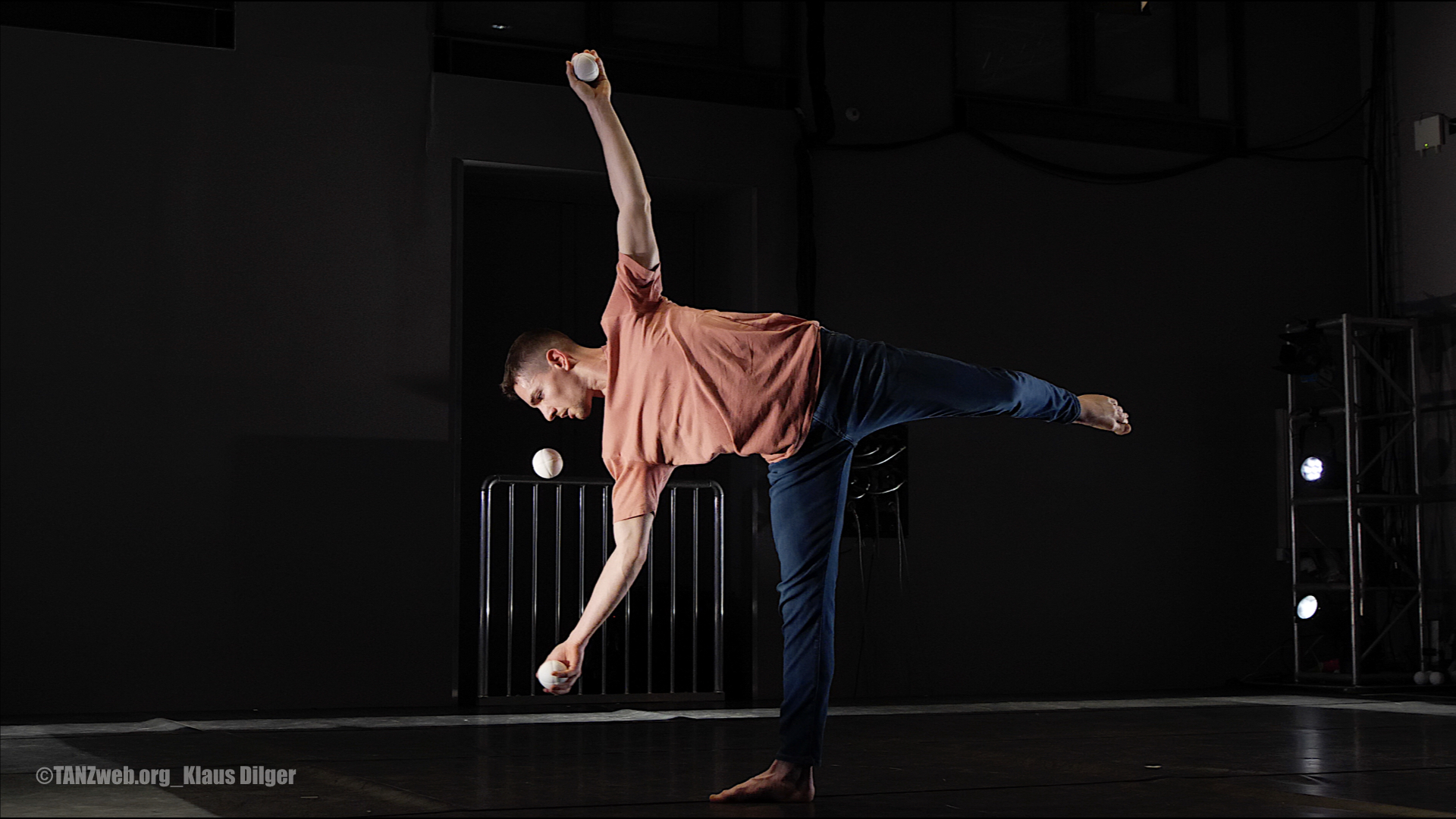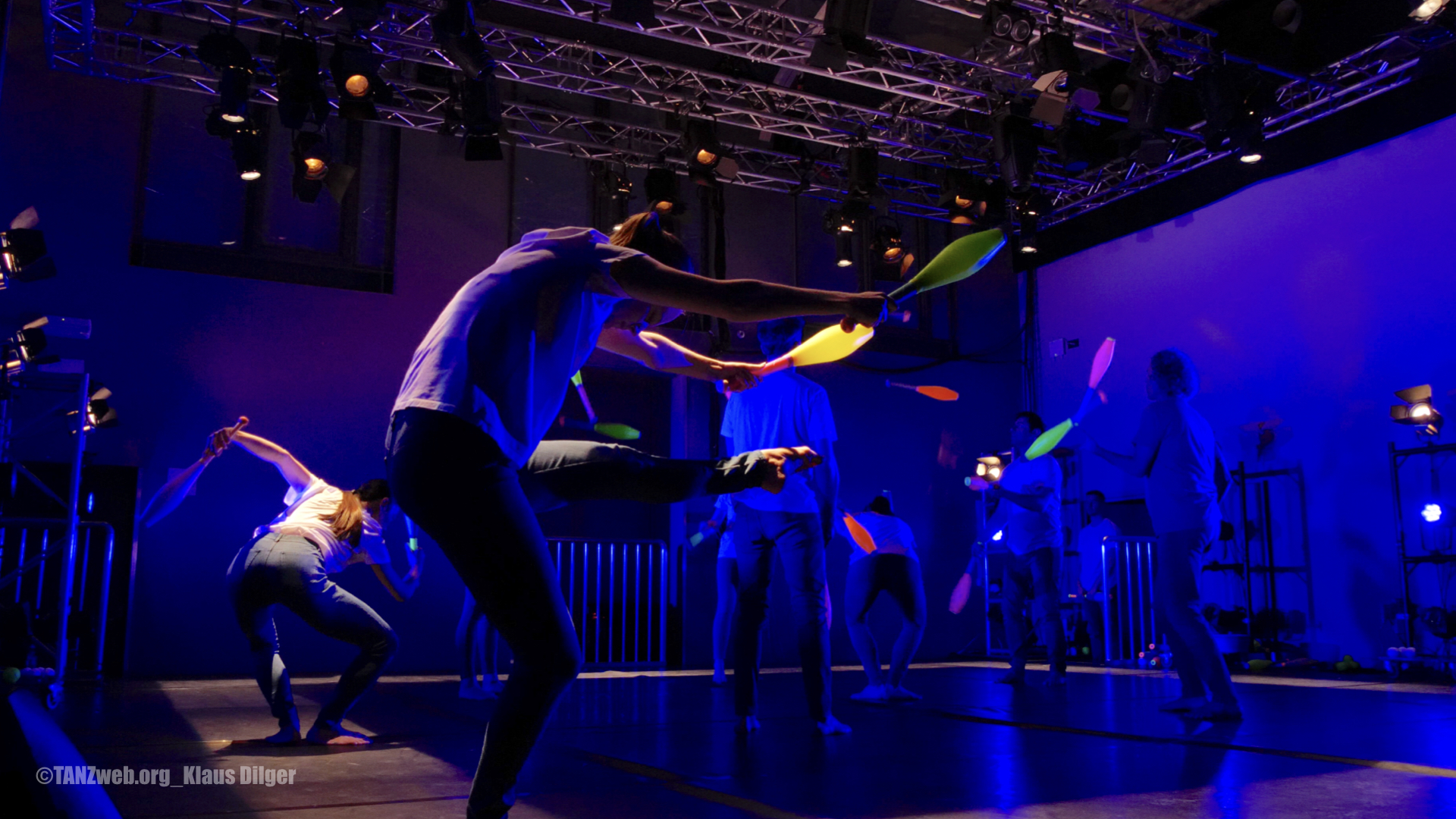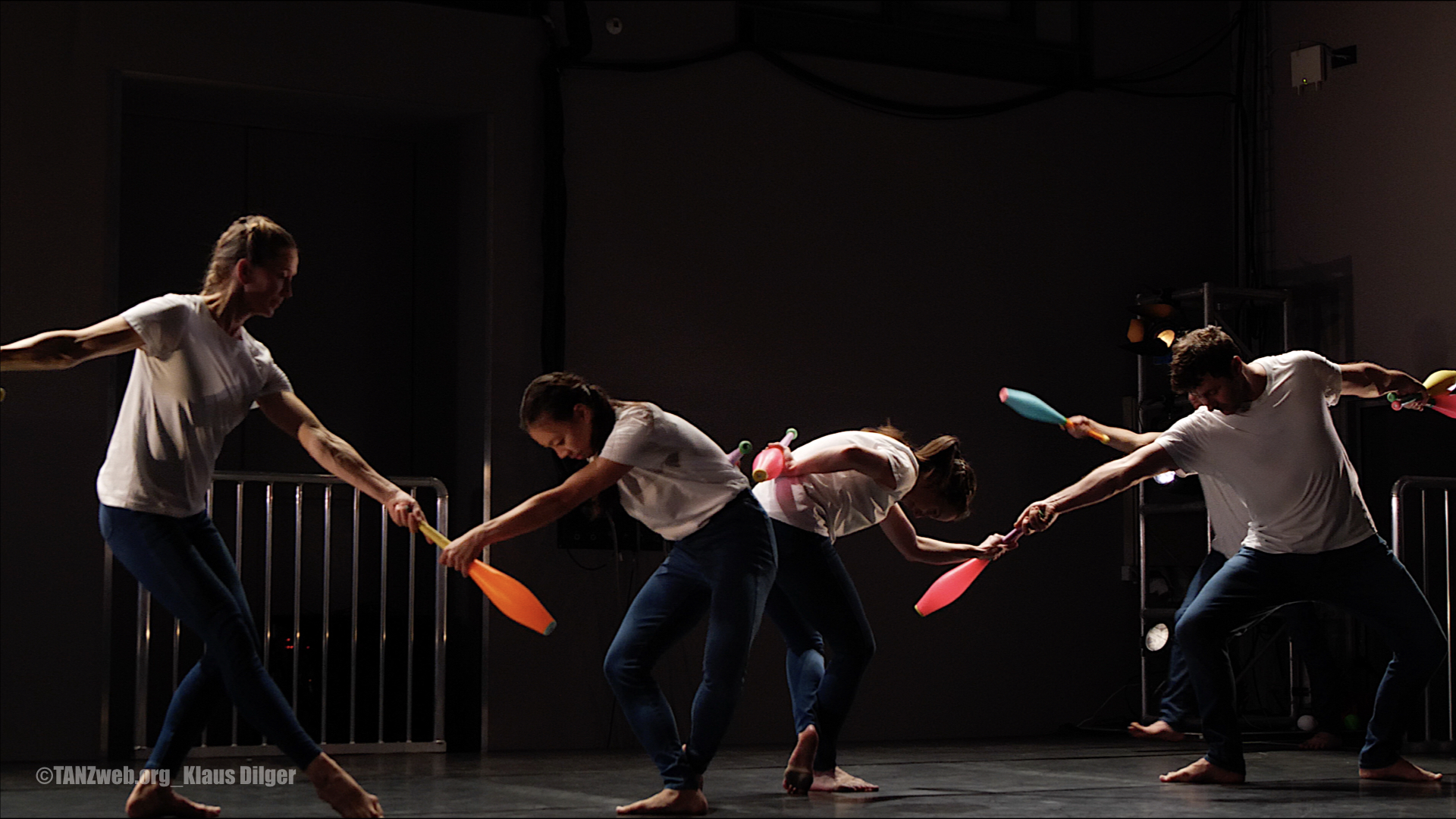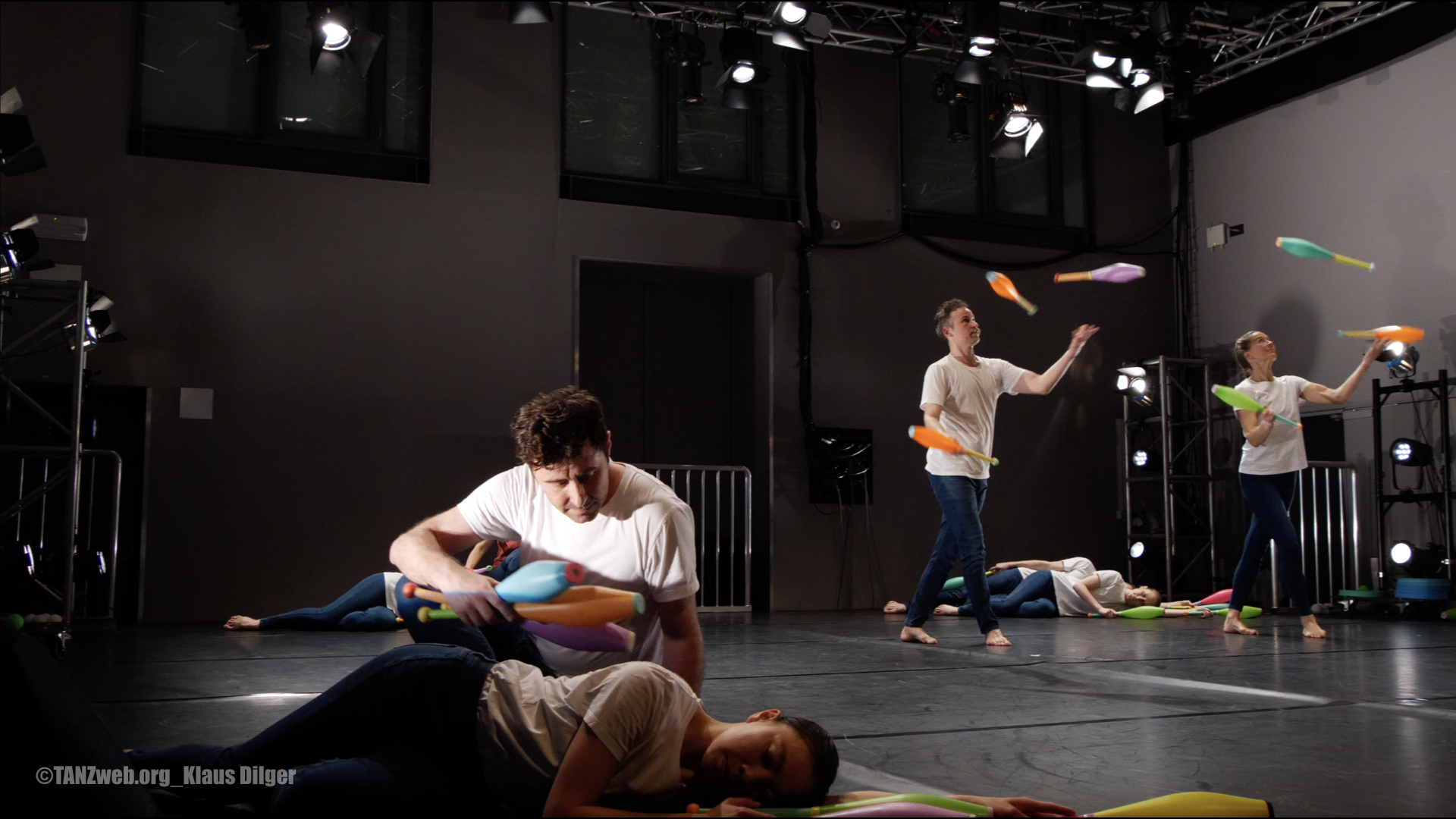schrit_tmacher festival 2024 now also open in Belgium
Ball, ring and club
Whatever you think of juggling: In Sean Gandini’s „LIFE. A Love Letter to Merce Cunningham“, it almost playfully opens our eyes to one of the most dazzling and exceptional figures in contemporary dance.
By Harff-Peter Schönherr
Everyone loves receiving love letters. But what if the delivery runs into problems? This is the case with „LIFE“, Sean Gandini’s „Love Letter to Merce Cunningham“, at least at first glance: Cunningham, the great experimenter, is no longer with us. However, anyone who experiences Gandini’s homage to the exceptional American dancer and choreographer, which is also an experiment, realises that this letter is addressed to all of us, and not just as a substitute.
We don’t know what Cunningham would think if he were to see Gandini’s declaration of love. The British daily newspaper „The Guardian“ is certain that he „would have loved this little gem of a show“. But of course that’s nothing more than an assumption.
Many things fit together on this evening in Eupen, Belgium. It is taking place in the Alter Schlachthof, not a genuine cultural venue: Cunningham also liked showing his dance in unusual places. He also combines dance with juggling: Cunningham has taken similar avant-garde liberties that transcend genres.
In Eupen’s „Old Slaughterhouse“, built between 1901 and 1903, animals died until 1991 – and with them, perhaps, a little of the souls of those who used the brutal equipment that awaits us in a display case at the entrance: huge meat cleavers, electric cattle prods, 9 mm calibre killing cartridges for „heavy pigs, cows, light oxen“.
Even today, it is sometimes a matter of life and death, in our minds, of how we treat our fellow creatures. „LIFE“ is an attempt to fit in here. At least that’s what the title implies, suggesting that death is not just an end. And that is true, to a certain extent. Because Cunningham lives on, even in Gandini, who draws on Cunningham’s choreography and techniques for the „exciting dialogue“ between juggling and dance that „schrit_tmacher“ promises us.
What would be, „schrit_tmacher“ formulates the question of the evening, if Cunningham had choreographed juggling? Of course, there is no answer to that. Just as it is impossible to answer what would have happened if Cunningham had choreographed sword swallowing. Or, let’s say: High trapeze. You just don’t know.
But perhaps that’s not even necessary. Gandini’s approach to Cunningham lasts 60 minutes. And in the end it can be said: yes, juggling and dancing, throwing and catching to Cunningham’s movement patterns work. And the fact that there is an empty chair on stage at the end is touching: someone is missing here, it says. And at the same time: someone is not missing here.
The evening makes no attempt to be a didactic play. Above all, it is fun. This is particularly down to Gandini himself. The way he explains the basics of juggling at the beginning, and thus also the basics of the Cunningham technique, is funny and captivating. „We love drops!“ he smiles. And, yes, the world-class jugglers who make up „Gandini Juggling“ also perform them. Also on this evening.
We learn what forms such as „fountain“ and „column“ are all about, what rhythm is inherent in juggling. Here, at the latest, it becomes clear: sword swallowing and high trapeze are not a good comparison. Because what Gandini’s throwers and catchers perfect is rhythm. The dance does the same.
And then it starts: balls, rings and clubs are used. A few at first, then more. Often in solos and often in passing, between many actors, with throwing and changing positions, and that is always a small miracle of coordination.
Of course, the juggling part attracts a lot of attention. It is colourful, fast, spectacular and glittering. Balls rest on elbows, roll magically from foot to foot, rings encircle necks and legs, clubs trace body contours, hands pluck flying, whirling, floating objects out of the air with dreamlike confidence.
But the level of dance is not left behind: Gandini’s jugglers are also good dancers. Jumps can be seen, lifting figures, pirouettes, foot positions, accentuated, emphasised, reinforced by objects in the air. A double layer that must have taken courage to construct.
Everyone likes to receive love letters. But what if they are difficult to understand? This is where „LIFE“ takes a risk: the juggling level is immediately accessible to everyone, the Cunningham level only to those with excellent background knowledge, preferably their own dance experience. Of course, Gandini explains in exemplary fashion how his synergy works, where the levels meet and overlap. But for the uninitiated, the rest of the evening still poses puzzles. The good thing about it: solving puzzles is fun. At least as much fun as watching balls, rings and clubs whirl around.
Gandini does not shy away from disturbances in „LIFE“. Balls clatter against walls like projectiles. Clubs fly into the corner, are thrashed on the floor, make bars vibrate, resemble bullfighting banderillas in a pas de deux. When it comes to left and right throwing and catching hands, Gandini sometimes draws a parallel to the fronts of politics. And then there is this moment in which one of the performers stands dramatically motionless for an endless amount of time, as if waiting, as if preparing, and at the end, instead of doing something particularly astonishing, simply says: „I’m done!“ And winks. And leaves. Marvellous.
An eye-opening, relaxing evening. An evening that children can enjoy just as much as adults. At the end, Gandini thanks the audience for being there. For wanting to see his declaration of love, even though „there are a lot of really good Netflix series on at the moment“. That’s not just a slogan. He’s really pleased.
On the way out, there’s another display case to the left of the door. A brochure is on display there: „The whole thing about cooked sausage production“. Fierce. Far better to let the ball, ring and club circle. Or, like Cunningham, to the question of how he has managed to recreate himself over and over again, to find the answer: „Shouldn’t we all do that?“

















